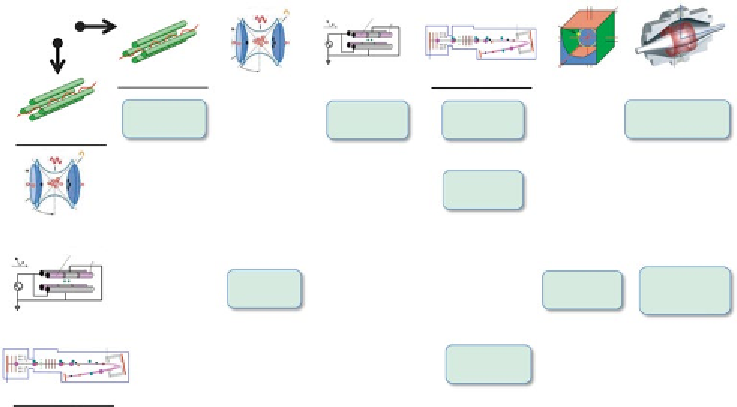Biology Reference
In-Depth Information
analysis. Very little sample is wasted and therefore MALDI can
achieve high levels of sensitivity, often <1 × 10
−15
mol. In addition,
MALDI can produce very large singly charged ions and thus the
type of mass spectrometer most widely used with MALDI is the
TOF due to its large mass range. However, the presence of matrix
ions cause large chemical noise at
m
/
z
< 500, and thus low molecu-
lar mass analytes are difficult to analyze by MALDI.
4
Analytical Innovations in the Proteomics Era: The Trend to Hybridization
Concurrent with the development of ionization methods, several
innovations in mass analyzer technology expanded the range of
applications in biological research. Though innovations involve the
design of individual mass analyzers, the trend in contemporary
biological mass spectrometry is mass analyzer hybridization because
hybrid configurations possess additional functional capabilities.
Figure
3
displays hybrid configurations widely used in current bio-
molecular mass spectrometry. The simplest hybrid configuration,
tandem mass spectrometry (MS/MS), involves more than one step
of mass selection or analysis, and fragmentation is usually induced
between these steps. Several types of tandem mass spectrometers
have been designed through combinations of the six classes of
major mass analyzers currently used in biomolecular analysis:
Time-of-flight (TOF), Quadrupole (Q), 3D Ion Trap (3D-IT),
2
r
MS
x
Positive voltage
y
z
Is applied
z
b
1
a
LIFT
c
3D ion trap Linear ion trap
Quadrupole
Time of flight
Orbitrap
FT-ICR
QQQ
QLIT
QTOF
Q-Orbitrap
Quadrupole
IT-TOF
3D ion trap
x
Positive voltage
Is applied
y
z
LTQ-
Orbitrap
LT Q
LTQ-FT
Linear ion trap
TOF-TOF
LIFT
Time of flight
Fig.
3
Hybrid configurations widely used in current biomolecular mass spectrometry. Beam-type instruments'
names are
underlined
. Trapping instruments are highlighted in
bold face
. Note that quadrupoles are not used only
as mass analyzers; they also are implemented frequently as ion transfer optics, collision cells, and linear ion traps

